www.GemstoneBasics.com
Photomicrography > Corundum > Magmatic rubies
First draft: May 15th, 2014 | Last update: April 4th, 2017
Some Features Observed in Magmatic Rubies & Sapphires
Australia, Cambodia, southern China, Kenya, Laos, northern Madagascar, Thailand & southern Vietnam
The inclusion scene observed in magmatic corundums is completely different from that of their metamorphic counterparts. Consequently, microscopic observation generally renders it possible to distinguish between both families. Yet, magmatic sapphires do not share the same genesis as magmatic rubies.
Magmatic sapphires crystallised from (partially) melted mantle material, while magmatic rubies formed due to metamorphism of mafic to ultramafic rocks at great depths and thus under substantially higher pressures and temperatures than in metamorphic environments, resulting in a particular inclusion scene.
References and items of related interest
Coenraads, R.R. (1992). Surface features on natural rubies and sapphires derived from volcanic provinces. The Journal of Gemmology, Vol. 23, No. 3, pp. 151-160.
Coenraads, R.R. (1992a). Sapphires and rubies associated with volcanic provinces: inclusions and surface features shed light on their origin. The Australian Gemmologist, August, pp. 70-78.
Coenraads, R.R., Sutherland, F.L. & Kinny, P.D. (1990). The Origin of sapphires: U-Pb dating of zircon inclusions sheds new light. Mineralogical Magazine, Vol. 54. pp. 113-22. Mineralogical Magazine Tables of Contents
Collins, A.S. (2000). The tectonic evolution of Madagascar: Its place in the East African Orogen. Gondwana Research, Vol. 3, No. 4, pp. 549–552.
Garnier, V., Giuliani, G., Ohnenstetter, D. & Schwarz, D. (2004). Saphirs & Rubis, Les gisements de corindon: classification et genese. Le Regne Mineral, No. 55, 47 p (in French).
Garnier, V., Ohnenstetter, D., Giuliani, G. & Schwarz, D. (2003). Revue des classifications des gisements de corindon. Chapitre 4, Ecole Doctorale RP2E, France (in French).
Giuliani, G., Ohnenstetter, D., Fallick, A.E., Groat, L. & Fagan, A.J. (2014). The geology and genesis of gem corundum deposits In: Groat, L.A. (Editor) Geology of gem deposits, pp. 29-112. Mineralogical Association of Canada, Short Course Series, Vol. 44, Quebec, Quebec, Canada, 405 p. ISBN 978-0-921294-54-2.
Gübelin, E.J. (1983).
The Precious Corundums Ruby and Sapphire In: Internal World of Gemstones. Documents from Space and Time, pp. 112-136.
3rd edition. ABC Edition, Zürich, Switzerland, 234 p. ISBN 3-85504-030-3.
Note: 1st Edition (1973). Innenwelt der Edelsteine. Urkunde aus Raum und Zeit.
ABC Edition, Zürich, Switzerland, 233 p. ISBN 3-85504-030-3 (in German; ISBN checked in the original copies).
Gübelin, E.J. & Koivula, J.I. (1997). Ruby and Sapphire and their Inclusions In: Photoatlas of Inclusions in Gemstones, pp. 324-361. 3rd revised edition. ABC Edition, Zürich, Switzerland, 532 p., ISBN 3-85504-095-8.
Gübelin, E.J. & Koivula, J.I. (2008). Inclusions in Major Commercial Gems: Ruby and Sapphire In: Photoatlas of Inclusions in Gemstones. Volume 3, pp. 53-353. Opinio Publishers, Basel, Switzerland, 672 p., ISBN 3-03999-029-2.
Guo, J.F., O'Reilly, S.Y. & Griffin, W.L. (1996). Corundum from basaltic terrains: an inclusion approach to the enigma. Contributions to Mineralogy and Petrology, Vol. 122, Issue 4 (January), pp. 368-386. abstract
Groat, L.A. (2014). Geology of Gem Deposits. 2nd Edition. Short Course Series, Vol. 44. Mineralogical Association of Canada, Québec, Québec, Canada, 405 p. ISBN 978-0-921294-54-2. Mineralogical Association of Canada
Handke, M.J., Tucker, R.D. & Ashwal, L. (1999). Neoproterozoic continental arc magmatism in west-central Madagascar. Geology, Vol. 27, No. 4, pp. 351–354. abstract
Hänni, H.A. (1994). Origin determination for gemstones: possibilities, restrictions and reliability. The Journal of Gemmology, Vol. 24, No. 3, pp. 139-148. Also published on www.ssef.ch
Kievlenko, E.Y. (2003). Geology of Gems. English Ed., Ocean Pictures Ltd., Littleton, CO, USA, 432 p. + 32 p. plates. ISBN 978-5900395258.
Levinson, A.A. & Cook, F.A. (1994). Gem Corundum in Alkali Basalt Origin and Occurrence. Gems & Gemology, Vol. 30, No. 4, pp. 253-262.
Pain, C.F. (1983). Geomorphology of the Barrington Tops area, New South Wales. The Journal of the Geological Society of Australia, Vol. 30, pp. 187-94. abstract
Peucat, J.-J., Ruffault, P., Fritsch, E., Simonet, C., Bouhnik-Le Coz, M. & Lasnier, B. (2005). Un nouvel outil géochimique de reconnaissance des saphirs bleus basaltiques et métamorphiques: le rapport Ga/Mg. Revue de Gemmologie, Association Française de Gemmologie, No. 153, pp. 8-12 (in French).
Schwarz, D. (1998). Aus Basalten, Marmoren und Pegmatiten. Spezielle Ursachen form ten in der Erdkruste edle Rubine und Saphire In: Glas, M. (Editor) Rubin, Saphir, Korund: schan, hart, selten, kostbar. extraLapis, No. 15, pp. 5-9. Christian Weise Verlag, München, Germany, 96 p. ISBN 9-921656-45-1 (in German).
Simonet, C. (1997). Géologie des Gisements de Saphirs. Diplôme d'Université de Gemmologie (DUG) Dissertation, University of Nantes, 82 p. (in French). Published on www.gemnantes.fr
Silva, K.K.M.W. & Siriwardena, C.H.E.R. (1988). Geology and the origin of the corundum-bearing skarn at Bakamuna, Sri Lanka. Mineralium Deposita, Vol. 23, Issue 3 (July), pp. 186-190. abstract + references
Sorkhabi, R.B. & Stump, E. (1993). Rise of the Himalaya: A geochronologic approach. GSA Today, Vol. 3, No. 4, pp. 85, 88-92.
Sutherland, F.L. & Schwarz, D. (2001). Origin of gem corundums from basaltic fields. The Australian Gemmologist, First Quarter, Vol. 21, pp. 30-33.
Sutherland, F.L. & Schwarz, D. (2003). Origin of gem corundums. The Journal of Gemmology, Vol. 28, No. 8, pp. 473-452.
Sutherland, F.L., Hoskin, P.W.O., Fanning, C.M. & Coenraads, R.R. (1998a). Models of corundum origin from alkali basaltic terrains: a reappraisal. Contributions to Mineralogy and Petrology, Vol. 133, Issue 4 (December), pp. 356-372. abstract
Sutherland, F.L., Schwarz, D., Jobbins, E.A., Coenraads, R.R. & Webb, G. (1998b). Distinctive gem corundum suites from discrete basalt fields, a comparative study of Barrington, Australia, and West Pailin, Cambodia, gem fields. The Journal of Gemmology, Vol. 26, No. 2, pp. 65-85.
Wade, S. (2002). Origin blues. Colored Stone, Vol. 15, No. 3, pp. 38-39.
Zaw, K., Sutherland, L., Graham, I. & McGee, B. (2008). Dating zircon inclusions in gem corundums from placer deposits, as a guide to their origin. 33rd International Geological Congress, Oslo, August 6-14th. abstract
Photomicrographs of Magmatic Rubies
 - LoResC.jpg)
Polysynthetic twinning
40x (FoV ± 3.5mm) X-Pol
 - LoResC.jpg)
Polysynthetic twinning
50x (FoV ± 2.5mm) X-Pol
 - LoRes.jpg)
Polysynthetic twinning
25x (FoV ± 4mm) X-Pol
 LoRes.jpg)
Polysynthetic twinning along rhombohedral faces in a 1.25ct natural (magmatic) ruby
18x (FoV ± 4mm) X-Pol
 LoRes.jpg)
Surface reaching (a bit hard to see) twin planes observed in magmatic ruby
18x (FoV ± 3mm) X-Pol
 - LoResC.jpg)
Surface reaching twinning plane
30x (FoV ± 3.5mm) X-Pol
 - LoResC.jpg)
Negative crystal & veil with two-phase filling
50x (FoV ± 2.5mm) Obl
 - LoResC.jpg)
Boehmite, negative crystal & veils
30x (FoV ± 3.5mm) Obl, Sh
 - LoResC.jpg)
2-phase negative crystals are common
50x (FoV ± 2.5mm) Obl, Sh, Pol
 - LoResC.jpg)
Negative crystal intersected by twin planes
50x (FoV ± 2.5mm) Obl, Sh, Pol
 S2, DSS - LoRes.jpg)
Minute veils of fluid inclusions
50x (FoV ± 2.5mm) DF, Pol
 - DS, Sh SE, Sm, C0.4 - LoRes (c).jpg)
Rosettes
50x (FoV ± 2.5mm) Obl, Pol
.jpg)
Pyrrhotite crystal & veils
30x (FoV ± 3.5mm) Obl, Sh, Pol
 - LoResC.jpg)
Pyrrhotite and negative crystals are always truncated
50x (FoV ± 2.5mm) Obl, Pol
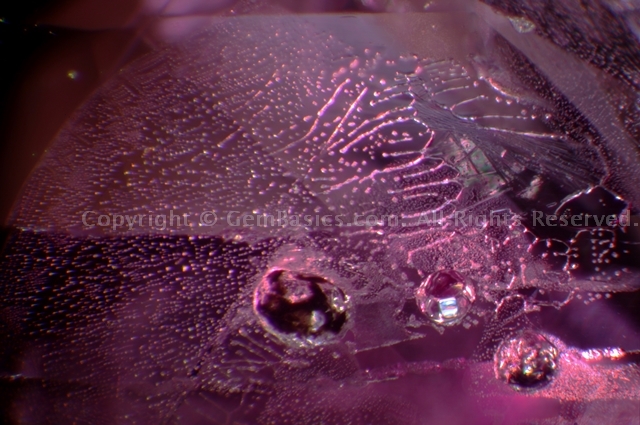
Pyrrhotite and its archetypal surrounding fingerprint - gem courtesy of J.C. Höfelt
40x (FoV ± 3mm) Obl, Pol

Magmatic corundums often contain negative crystals with glassy residues
50x (FoV ± 2.5mm) Obl, Pol
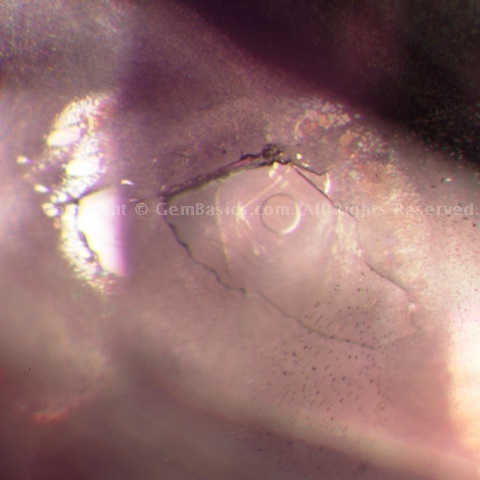
Fluid inclusions in a 1.22ct ruby
50x (FoV ± 2.5mm) Obl, Pol
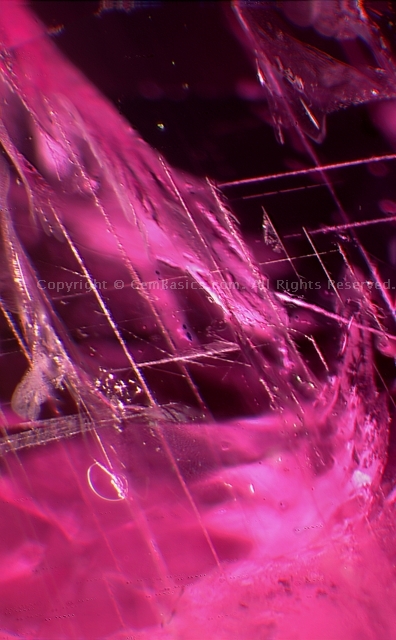
Boehmite needles along twinning planes
35x (FoV ± 3.5mm) Obl, Pol

Boehmite needles with fringes
50x (FoV ± 2mm) Obl, Pol
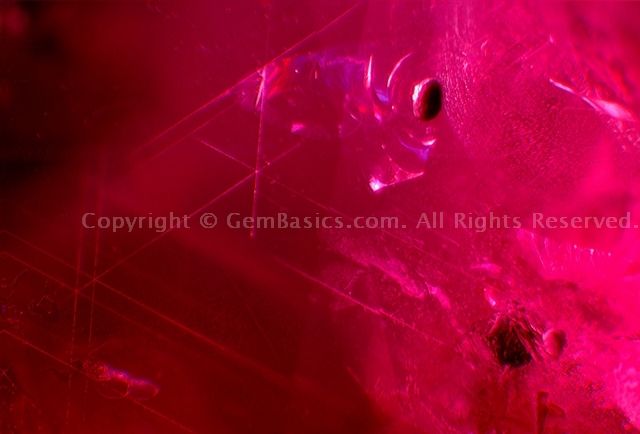
Boehmite along 3D intersecting twin lamellae emphasises the rhombohedron and is diagnostic for magmatic rubies
30x (FoV ± 4mm) Obl, Pol
 LoRes.jpg)
Boehmite needles and negative 2-phase inclusions
30x (FoV ± 2.5mm) Obl, Pol
Very often, identifying inclusions is quite problematic. Protogenetic inclusions are mostly heavily worn or damaged, lack crystal habit, and prevent identification while heat treatment provokes discoloration of inclusions and formation of stress haloes. Such problems calling for analysis are presented in the following photomicrograph of a 0.77ct which intuitively would indicate a magmatic origin.
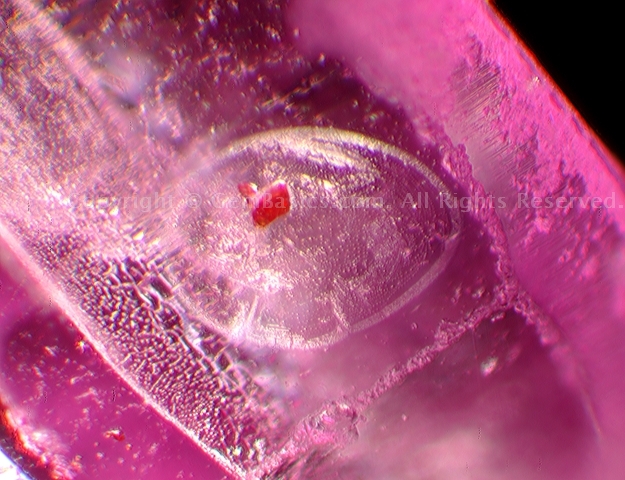
Mind games of a ruby: uranium pyrochlore, rutile, garnet... or perhaps something else?
25x (FoV ± 3mm) Obl, Pol
The inclusion may be a strong indication for a heat-treated stone in which a pre-existing inclusion has been altered causing the surrounding tension halo.
But the appearance of this particular scene is strikingly similar to uranium pyrochlore inclusions found in magmatic sapphires which may stir up confusion.
A case like this illustrates the point where gem labs are usually called in. Non-destructive analysis of the inclusion and of the stone are necessary in order to provide us with clear answers.
Photomicrographs of Magmatic Sapphires
 LoRes.jpg)
Extremely conspicuous boehmite inclusions with iron oxides (?) & fluid inclusions
18x (FoV ± 3.5mm) X-Pol, Fiber illumination
 LoRes.jpg)
The boehmite inclusions are aligned along the twin planes - note the interference colours
18x (FoV ± 3.5mm) X-Pol, Fiber illumination
 LoRes.jpg)
Boehmite and small aligned "fingerprints": a detail
50x (FoV ± 1.7mm) X-Pol, Fiber ill.
 LoRes.jpg)
Such fingerprints, such as the left part of this example, are diagnostic for the origin of this 2.83ct untreated sapphire
30x (FoV ± 2.0mm) Fiber illumination, Pol
 Crystal, Halo, FP & Comet.jpg)
(Almost) a full house: crystals (plagioclase ?) with haloes, a comet (zircon ?), and liquid feathers
50x (FoV ± 2.0mm) Fiber illumination, X-Pol
.jpg)
A more detailed recording of one of the supposedly plagioclase crystals
50x (FoV ± 1.0mm) Fiber illumination, X-Pol
